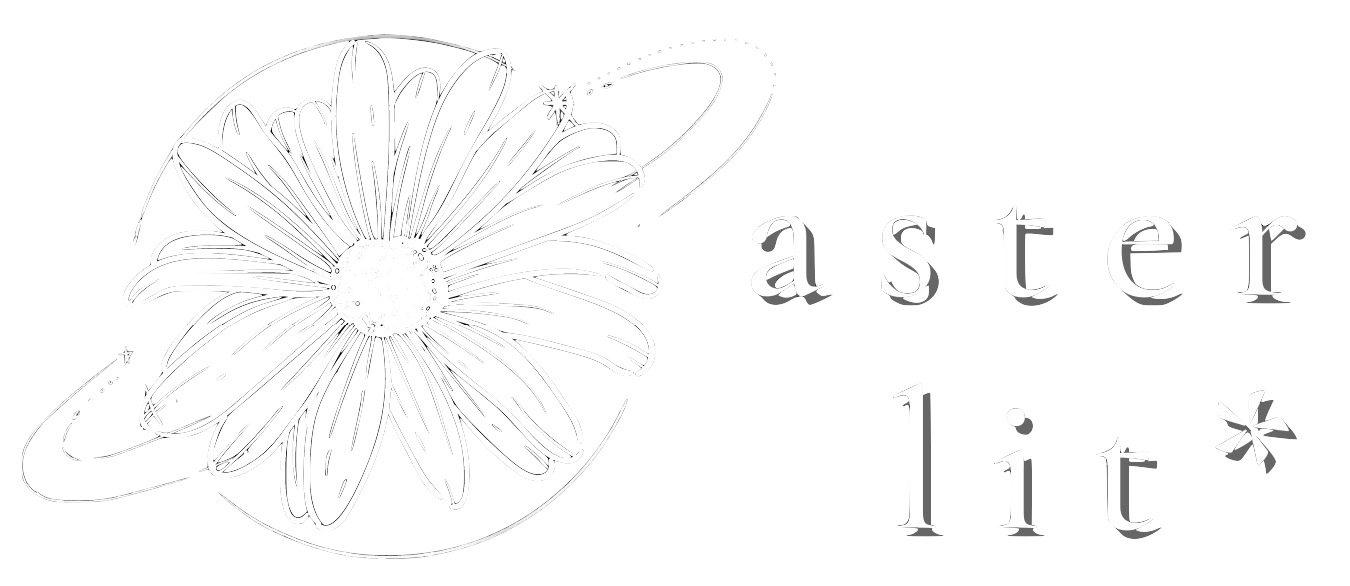
Aster Lit: Translatability
Issue 12—Summer 2024
Aster Lit’s Special Issue:
Aster Lit Issue 12 is a celebration of translation and multilingualism. In this special issue, we explore the nuances between languages, dialects, tones, grammar structures, and other pillars of expression. From code-switching to dictionary-driven translations, the wonders, difficulties, and a-ha moments of seeing the world through language have made an impact on all of us. 195 countries, 6,500+ languages, 1 planet—let’s interrogate the philosophies behind what makes communication multifaceted and human.
translatability
n.
a property that allows an idea, word, and feeling to flow from one realm of understanding to the next

Note from the Editors
“The duality of our human language often haunts me, scares me—because when all words fail, how could I reach you then? There are these thoughts forever lost in the pursuit of translation, like when I tell you the words I love you in English because it is often the language we are taught in the school halls where I met you. There are gaps between the spaces of what I wrote here, and what I meant. There is a distance between my hand and my heart of which I cannot make the ends meet.”
—Mahal by Yen Valencia (Philippines)
Amongst the nearly 8 billion people on our planet, language—in all forms—define how we communicate. These words consume us, connect us, create us, creating visions that can be shared and savored.
This summer, in a program with students from fifteen other countries, we play trilingual telephone. Semantics and syntax spill from one language to the next like how a chord ricochets through an orchestra, like sense-syncing frisson, like phone calls with my grandmother at 2 a.m. when an idiom hits just right.
We compare grammar and political systems, the counterintuitive preference of expressing anger or talking to ourselves in our non-native language; I read past Aster Lit issues to my host sister who exclaims "this is Egypt!" to Farai Chaka's "poem most likely to be burnt."
I call the Aster Lit team. I think about our readers, our contributors, the distance yet intimacy of the words that bridge us. Zoom screens, profile pictures, paragraphs vomited into word processors when we don’t have the strength to say them out loud—I keep thinking about the phrase “the world through our eyes,” or maybe more accurately, “the world through our words.” After all, who are we but the way we piece together the world, the way we communicate why it matters?
As such, we’ve been translating since the moment we’ve opened our eyes—senses to nerve impulses, signals to conscious thought, thought to sound to image to writing. Translation is the heartbeat of our interactions with the world. The act of conceptualization. The act of communication.
But as the common adage goes: "The only thing about which fish know nothing is water."
Even as an international youth literary magazine dedicated to illuminating diverse voices, we've never formally addressed and examined translation as an act, nor as a medium. By requesting submissions in English, the majority of our submitters must translate or juggle the mentality of several languages to arrive at an authentic yet accessible work that we, as editors, eventually read. This then goes through subsequent layers of re-contextualization before publication, from in-house edits to issue display. We conduct this process like a habit, but often forget to appreciate each decision along the way, marvel at the intricacy of unifying so many different voices and ways of thinking under one theme, one issue, one magazine.
Thus, this issue was born. Interdisciplinary features illustrate different sides of translating and interpreting our experiences; and interviews, as inspired by Winter Tangerine's Skins Skins, dive into the reasoning of each contributor as they grapple with language, culture, history, and meaning. We even consulted the experts—renowned writers Victoria Chang and Saba Keramati—to explore their literary processes in regard to multiliinguality.
This summer, we also welcomed our first cohort of interns, translating the mission and passion of Aster Lit to new hands across three continents. After working at each of our four branches and reading and discussing copious amounts of world literature (including your submissions!), our interns wrote reflections on translation, comparative literature, and their own experiences with multilinguality. You may find their works under Editor Contributions.
As you explore these thoughtful and powerful works, we hope they touch you the way they did us. We hope they live on in the way you see language and code-switching—from diaspora religious experiences to incomprehensible grief to AI—sparking new generations of writing, art, or whatever genre-breaking form fits your view of the world. Follow us on Instagram (@aster.lit) and once our submissions open, send them our way!
We love you. Your voice matters. Keep telling stories.
With all our love,
Emma Zhang (Co-Editor-in-Chief) & The Aster Lit Team

Starlit Winners
Each issue, we hope to recognize submissions outstanding in mastery of craft and originality of voice. This issue, the winner of the Starlit Award will receive a monetary award of $100. We are proud to present the Issue 12 Starlit Award for Poetry to Leela Raj-Sankar (United States) and the Starlit Award for Prose to Sripurna Majumdar (India). The honorable mention recipients are Audrey Nguyen (Vietnam & Canada) for Poetry and Rosalind Kong (United States) for Prose.
Leela Raj-Sankar
Audrey Nguyen
Sripurna Majumdar
Rosalind Kong
“The multitude of approaches to translation: viewing it as repetition, adaptation, evolution, interpretation, illumination and fragmentation shows the diversity of perspectives in translating translation.”
— “Translating Translation” by Sripurna Majumdar —

Contributors
Abhisek Nayak - Illustration Series - interview
Audrey Nguyen - 2 pieces - interview
Audrey Wang - 房顶 (a translation of “The Roof” By John Collings Squire, Sir)
Emmanuel Lacadin - Amihan Mornings - interview
Leela Raj-Sankar - 2 pieces - interview
Maleeha Bukhari - Shanakht III - interview
Noori - letters for lévi-strauss from barzakh - interview
Rakshithaa V Jaiganesh - TOUCH & SKY - interview
Rosalind Kong - The 阿姨们 at Art Class - interview
Saheed Sunday - Nyame Dua - interview
Sophia Liu - Photo Series - interview
Sripurna Majumdar - Translating Translation - interview
Suchita Senthil Kumar - Uyirmei Ezhuthukkal - interview
William Achere - Esselle'a'Ndolo (The Love piece) - interview
Yen Valencia - mahal: love as the first language i’ve ever known - interview

Interviews
Emails with Victoria Chang - Celina Simone
A Conversation with Saba Keramati - Celina Simone
translatability
अनुवादनीयता
traduzibilidade
переводимость
khả năng dịch
tłumaczalność
ژباړه
translatability अनुवादनीयता traduzibilidade переводимость khả năng dịch tłumaczalność ژباړه

Editor Contributions
The Tragedy of Translation (and Why We Must Continue) - Naomi Ferrao
Traduttore, Traditore - Elizabeth Rotunno
Art as Mistranslation. - Lucien
Seashells and Swamps - Nabeeha Sheikh
If/and - Elizabeth Rotunno
Mother—Why can I not speak? - Zara Hafeez Siddiqui
mind to heart, heart to mind - Joyce Lee
Written in the past, read in the future - Joudy Khaled
Translations from an imaginary poet - Naomi Ferrao
Translating Picture Books as a Love Language - Jane Lee
Unspoken Alleys - Tony Pan




